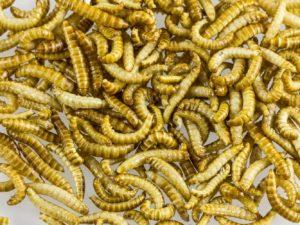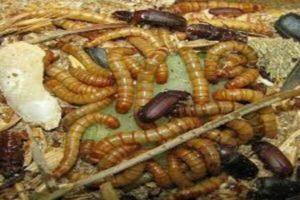Flour beetle hrushchak and its larva: a pest of kitchen supplies
In almost any housewife in the kitchen, you can find flour or various cereals. These are products that are part of the main diet of a healthy diet and very often people make small supplies on the shelves at home. After some time, inside the bags with cereals, you can find traces of the vital activity of harmful insects, one of which may be a flour beetle.
Content
Flour beetle: photo
Who is a flour hrushchak
Name: Flour beetle or flour beetle
Latin: Tenebrius molitorClass: Insects - Insecta
Squad: Coleoptera - Coleoptera
Family: Chernotelki - Tenebrionidae
 | Habitats: | warehouses, houses, stocks |
 | Dangerous for: | food |
 | Means of destruction: | chemistry, temperature effects |
Flour beetles are called representatives of several species from the dark beetle family. The larvae of these insects are dangerous pests and spoil the food stocks of people.
Hrushchaks are very similar in appearance. Their bodies are flat, oblong in shape and have rounded edges, but can vary greatly in size and coloration.
Habitat of flour beetles
Large mealworms are distributed almost all over the world and are among the cosmopolitan animal species. Although, initially the habitat of this insect species was concentrated in the Mediterranean. Other types of flour beetles are also widespread in Russia, Ukraine and in the countries of Central Asia.
Lifestyle and harmfulness of flour beetles
Adult beetles are active mainly in the dark, and flying species of beetles can be observed near luminous lamps. Pests are both adult beetles and larvae. They settle near food sources and litter stocks with waste products. Habitual habitats mealworms are:
- bakeries;
- food warehouses;
- granaries;
- pasta factories.
Khrushchaks can easily live even inside various devices and mechanisms designed for grinding grain. In addition, in rooms that are heated, favorable conditions are created for beetles, and they can breed all year round.
Flour beetles most often harm products such as:
- flour;
- bran;
- seeds of cultivated plants;
- various cereals;
- dried fruits;
- crushed kernels of peanuts, beans or peas;
- wool products;
- natural fabrics.
Products damaged by this beetle become unfit for human consumption. In flour and bran, lumps, insect excrement and shells shed by larvae after molting appear. Also, the product acquires a sharp unpleasant odor, which is almost impossible to get rid of.
How to get rid of flour beetle
Fighting flour beetles is very difficult. If these insects have already settled in the house, then you will have to completely get rid of all food stocks.
Tips such as sifting and freezing will not completely solve the problem.
With the help of a sieve, you can only get rid of large larvae, while eggs laid by beetles will easily pass through even the tiniest holes. As for freezing, only temperatures below -7 degrees Celsius will help destroy pests.
The simplest and most effective method of dealing with beetles is to call exterminators., but this can be an expensive "pleasure". Therefore, having noticed signs of the appearance of hruschaks, people try to get rid of them on their own, with the help of chemicals or folk recipes.
Chemicals
Among insecticidal preparations, you can find many means to combat hruschak. It is most convenient to use ready-made insecticides in the form of aerosols, powders or gels. Processing with such means should be carried out only after all food supplies have been thrown out of the house and this should be done very carefully.
The most popular drugs won:
- Raptor;
- Raid;
- Masha.
Folk methods of struggle
The only truly effective folk method of dealing with Khrushchak is considered heating food stocks. To do this, flour, cereals and other products that may be included in the diet of the beetle must be heated in the oven to a temperature of 80-100 degrees.
But, the taste after such a procedure may deteriorate or even become unusable.
preventive measures
The war with flour beetles is not an easy task. It is much easier to prevent and prevent the appearance of a dangerous insect in the kitchen. To do this, follow the following recommendations:
- store food in closed containers;
- maintain order and cleanliness in the kitchen;
- do not leave open the doors of tables or cabinets;
- regularly check food stocks for the presence of pest larvae in them;
- use repellent scents such as lavender, caucasian chamomile, or bay leaf;
- use mosquito nets in the summer.
Flour beetles as food insects
The larvae of the large flour beetle, which are also called "meal worms", are most often used as a food insect. They are very famous for their nutritional value and ease of breeding. Hrushchak larvae are used to feed such animals:
- birds;
- small animals;
- predatory ants;
- reptiles;
- amphibians;
- large aquarium fish.
Conclusion
Almost all types of flour beetles are very dangerous pests. These insects annually cause great damage to food stocks both in people's homes and in huge food warehouses. Therefore, it is very important to know your enemy by sight, because not all people, having noticed a harmless bug in the kitchen, begin to sound the alarm.
Previous

